Creeper World 4, then. I do enjoy tower defence as a genre and have got on famously well with games such as Defence Grid and Defender’s Quest and even the ancient Flash classic Desktop Tower Defence, but I’ve never managed to get into the Creeper World series. I think this is down to the series’ gimmick, where rather than defending against waves of enemies who rush in from offscreen to charge through your gauntlet of towers, you’re instead engaged in more of a hybrid RTS experience where you aggressively shuffle towers around the map to beat back a huge, constantly growing mass of purple goo called the Creeper that destroys everything it touches. It’s an interesting spin on the concept, and the guy behind Creeper World basically really likes making games out of simulations of cellular automata so the Creeper has always behaved like a believable fluid, pooling and flowing realistically before surging towards your woefully underprepared defence line. Unfortunately that hasn’t been all that clear up until this point, because the previous three Creeper World games were all top-down 2D affairs where you couldn’t really get a good impression of the true scale of the Creeper infestation; I ended up feeling more like I was fighting a war against the colour purple than I was a all-consuming blob monster and fell out of Creeper Worlds 2 and 3 quite quickly as a result.
Which, in a roundabout way, also explains why Creeper World 4 has been the one to finally click with me: it’s the first title in the series to go fully 3D, and so for the first time I am able to see just how sodding enormous the mass of Creeper bearing down on my base really is. This one change transforms Creeper World from what was ultimately a fairly standard turtling RTS game into something far more distinctive — and fun.
Each level of Creeper World starts the same way: a plain map of the terrain that doesn’t even have any Creeper on it to start with. Instead your opposition consists of a set of static structures that periodically generate Creeper — weird tentacle things that just spew the stuff out, spore launchers which fire aerial projectiles at your structures that’ll smear the ground in Creeper if they manage to land, nests of blobs that act as smart missiles for the Creeper that march straight for key structures and detonate them if they make contact, plus a few more nasty surprises that the campaign springs on you during the final levels. You start each level with the game paused, allowing you to survey the terrain, figure out where the pressure points are likely to be and select a good spot to deploy your base core. However, once you’ve done this and also plonked down a few starting structure blueprints you’ll have to unpause the game to actually build them, and it’s from this point that the clock is ticking; all of those enemy structures will start generating Creeper and you only have a very brief amount of time to set up a working defense before it starts encroaching on your base.
To fight the Creeper you have a surprisingly small range of the standard tower defence turrets — for most of the campaign you’re limited to a simple Cannon turret that shoots anything nearby, a Mortar with a longer range that can tear explosive swathes through the deepest regions of Creeper, defensive Missile and Sniper turrets that exclusively deal with the more targeted threats the Creeper sends at you such as the blobs and spore projectiles, and the Anti-Creeper turret that sprays out literal Anti-Creeper: a fluid that behaves just like the Creeper but which has no effect on your turrets and buildings and which will mutually annihilate the Creeper whenever the two fluids make contact. Towards the end of the campaign you do get access to some interesting toys such as shield towers and airstrips that let you launch bombers which drop either normal explosive bombs or payloads of Anti-Creeper, but for most of the campaign you’re handling those five basic types of turret.
This is because Creeper World 4 is more about logistics and the economy than it is finding the perfect combination of turrets to counter the Creeper. At the heart of very level of Creeper World 4 is the same relentless equation: all structures which generate Creeper are present on the map at level start and no more appear as the level progresses, so while the precise amount of Creeper generated will fluctuate up and down over time as each structure’s timer ticks over, when averaged out over a large enough period of time — say five or six minutes — the rate at which Creeper is generated is a constant X. You need to build a defensive network that is destroying Creeper at a rate of Y, where Y is larger than X; if you are doing this, then you will notice the Creeper starting to pull back as you destroy it faster than it can be created. If you can push it all the way back to a Creeper-generating structure, you can build a Nullifier next to it that stops that structure from making Creeper so long as the Nullifier is being fed by energy from your base core, permanently reducing X and further tilting the odds in your favour. But in order to achieve this you are going to need an awful lot of turrets constantly firing their guns to sustain that high rate of Creeper destruction, and all turrets require ammunition either in the form of raw energy or processed minerals extracted from various mineral patches on the map in order to keep firing; if you ever run out of either, or if the supply lines feeding them into your turrets ever get broken, then the turrets stop firing and the Creeper reasserts itself .
Thus the basic structure in Creeper World 4 — the thing you build before anything else — is not a turret but instead a simple Tower consisting of a pole stuck in the ground. Towers are both your energy generators and your supply lines; building one will cause a green field to appear in a small around the Tower which collects energy, while building Towers in reasonably close proximity to one another (and your core) creates a network of power lines along which energy and other materials can be transported. Crucially the transport time is not instant; Creeper World is smart and always picks the shortest possible route for moving energy and minerals from the core to your outlying turrets (unlike some other recent games I could mention), but the further away you go from your core the slower the reaction time will be if a turret needs an ammo refill, and if they’re too far away they can run out entirely before the new energy supplies reach it, so you need to be a little bit smart in planning your offensive against the Creeper so that you don’t end up overextended. There’s a couple of technologies that are eventually introduced to ameliorate this — Pylons which are more expensive and which don’t generate energy but which transport resources much faster, and a Porter building that stockpiles 100 of a given resource and then transports it to a target destination where it acts as a battery, allowing offensives into regions which are remote or even cut off from your tower network entirely — and which give you just enough flexibility on the logistics side to keep it an interesting challenge rather than a frustrating restriction.
But while the logistics side of the equation is solvable once you’ve invested the energy required to build those specialist transport structures, you still need to generate that energy in the first place. Some maps have patches of minerals that you can place (expensive) miners on to collect energy, but this is usually a backup and a supplement in maps where you have an unusually constrained start; most of your energy will be coming from the energy collection fields surrounding your Towers, and in order for these fields to function they need to be spread over a surface area that’s free of Creeper. Eventually you will have built Towers in all of the available space, and so the only way to expand your energy production further is to reclaim territory from the Creeper. And the way you do this is quite smart, because Creeper World’s other gimmick is that you can move your turrets around; simply select one and click on a spot on the map and it’ll pack up and slowly fly through the air to its new destination. The first 10-20 minutes of any Creeper World map are about forming a stable defensive line and supplying it with enough energy to keep firing, but once you’ve done this you can go on the attack by building a second line of turrets and moving them en masse to the edge of your current turret line’s weapon range. Once they’re down they’ll push the Creeper back, and you can set up a new line of Towers for energy supply and generation in the cleared space and then leapfrog your rear line over the front line again, repeating the process.
That’s the basic tactic, anyway. If every Creeper World map could be cleared using this method I wouldn’t think all that much of it as a game, but it’s smart enough to keep changing things up during the campaign so that you have to change your tactics as well. There’s missions where you have to cross empty void that can’t be built on, and so you need to mount what’s effectively a paradrop assault that’s supplied by energy batteries that you airlift in with Porters; a mission where Creeper is raining from the sky and you need to build shields to keep it from destroying your base; and missions where the Creeper is being protected by a dark energy field that needs to be cancelled out by special beacons before you can destroy it. My favourite was probably the classic RTS mission where you start inside a ruined fort with a lot of cracks and holes in the walls and the Creeper is coming from every side of the map in waves; you need to use terraformers to seal up the gaps and also build and supply enough turrets to keep the amount of Creeper from building up to the point where it swamps your fortress walls. Creeper World 4’s campaign has a very slow start — for the first five missions all you have to play with are Cannon and Mortar turrets and you are just doing the same thing over and over again, which is not particularly challenging — but once it does feel comfortable handing you some more tools there’s a fair amount of variety in here despite the campaign functioning more as an extended tutorial for the other game modes than it does a standalone thing itself.
If I had to make one criticism of the way Creeper World 4 is structured, it would be that everything comes back to that one core equation: that you are trying to get your rate of Creeper reduction Y to exceed the rate of Creeper generation X. Getting there can sometimes be a bit of a struggle, especially when a particular map’s gimmick blindsides you and trashes half your base; however, 100% of the Creeper’s threat is bound up in its ability to overwhelm your defense and ooze onto your base structures. It can’t really do anything offensive that’s not this, and so thanks to the static nature of Creeper World’s maps, where all Creeper generators are present at map start and no more are introduced as the level progresses, you will have seen all of the potential threats the Creeper can throw at you in the first ten minutes of the level. Once you have figured out how to counter all of those threats and grown your economy to the point where you’ve built enough turrets so that X is larger than Y — so that you’re destroying Creeper faster than it can be created — the map is effectively won since there’s no new sources of Creeper that can come online and the rest of the level can be viewed as either a long victory lap or tedious janitorial work where you sweep up the rest of the now non-threatening Creeper.
And this is where we come back to Creeper World 4 making the jump to 3D. This is not the first time I’ve made this criticism of a Creeper World game, and when I was playing Creeper World 3 I think it was a fatal flaw; I did not want to play god knows how many maps where I shot a series of purple tiles over and over again until the whole map was purple-free. Being able to see the Creeper actually flowing as a semi-realistic fluid changes my view of this completely, however; you can see it rippling out from its source generators in waves before crashing against your defensive line, which has to keep firing constantly in order to eat away at the base of the Creeper and stop itself from being overrun. As the rate at which Creeper can flow is governed by the amount of surface area it has to flow over, if your defensive line is set up at a narrow chokepoint then you’ll see the Creeper start to build up behind that chokepoint, until there’s a huge roiling sea of the stuff that looms over your tiny safe zone and which looks next to impossible to destroy. It’s just a matter of time and resources, though; massing enough Mortar batteries can carve out clear areas on the edge of the Creeper that give you a toehold for an advance, while bombers fly overhead and blast holes in this purple ocean that are quickly filled in, but which ever so gradually reduce the total amount of Creeper that you have to deal with. The key moments come when you’ve somehow battled through what initially looked like an overwhelming mass of Creeper to the source structures, where deploying a Nullifier suddenly renders a whole portion of the battlefield safe. This is a process that the 3D visuals makes satisfying in a way that Creeper World 4’s 2D predecessors could not, and so sticking around until the entire map is free of Creeper is much less offensive this time around.
Aside from that, the only other negative observation I’d make about Creeper World 4’s campaign specifically — I’m hesitant to call it a criticism, because I think it’s entirely intentional — is that I didn’t actually feel all that pressured at any point. Several times I had to restart a mission inside the first five minutes because I’d misunderstood whatever quirk the Creeper had on that level, but I never had to do this more than once per level and once I had a solid base of operations I never felt in danger of losing — the Creeper would sometimes destroy individual turrets or even entire outposts, but it never came close to threatening my base core, as I was constantly building new turrets and had five or six spares on standby that could be shuttled to any region that looked like it was in trouble. Overwhelming force and a slow, creeping advance that made sure each new region was absolutely locked down before I moved on to the next was my preferred strategy here, and a perfectly viable one for basic level completion. Creeper World 4 does have a set of leaderboards that judge you on metrics such as number of turrets built (fewer is better) and amount of time taken to finish the level that would require a riskier approach to excel in; it doesn’t want to force these strategies or even encourage them, it just lightly signposts that there’s a few more ways to play these levels that you can try if you want to.
Anyway, if you want a real challenge out of Creeper World 4 you’re not short on options; there’s a series of “experimental”, harder maps, daily missions, a random level generator where you can dial up all of the difficulty settings, and a library of user-made maps that have been put together with the bundled level editor. The campaign is the most structured part of the game and it’s where most people are going to go first, so it makes sense that it’s comparatively easy and I don’t think it’s particularly a flaw that it doesn’t force the player to play in a certain way; it’s competently constructed and has enough variety in it to stop you from getting bored, which is all I can really ask of an indie RTS. That goes for Creeper World 4 in general; it looks and feels like a throwback, with graphics that are functional rather than attractive and an overdetailed UI that’s straight out of an early 00s strategy title, but the Creeper is an interesting hook and the gameplay is distinctive and well-executed. I’m also very impressed that the tiny dev studio behind Creeper World (it is mostly just one guy, with some external support for the art assets) managed to make the jump from the comparatively simple 2D setup of the previous games to the full 3D view of Creeper World 4 in such an accomplished fashion — it feels like this was exactly what the series was missing, like it was always supposed to be 3D. The general look of the thing might be a bit primitive but Creeper World 4 is a game that knows exactly what it wants to be, and whose production values are far higher than most AAA titles I’ve played recently; load times are fast, crashes are zero, and there isn’t a single bug in the entire thing that I could see. And that’s really all I want out of an indie title these days1
- You have no idea what a relief it was to play Creeper World after the run of absolute dross I put myself through at the end of 2020. It was a much-needed reminder that there are developers out there who are perfectly capable of putting out a complete, polished product on the first attempt, and it’s very sad that it’s seemingly the exception rather than the rule these days. ↩

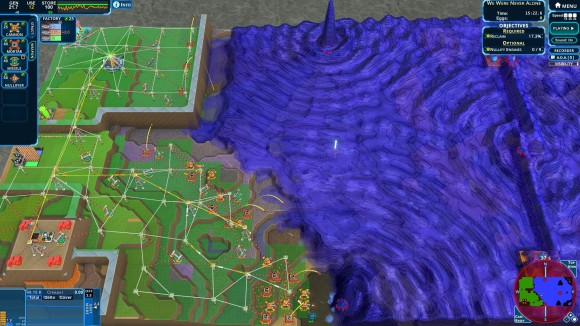
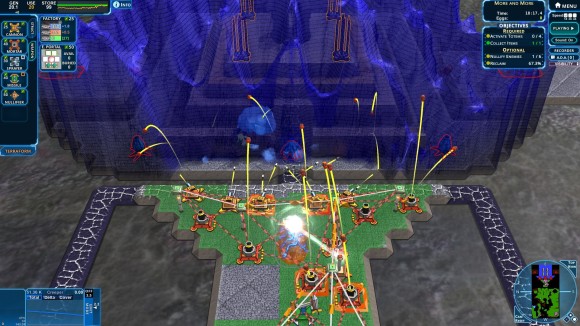
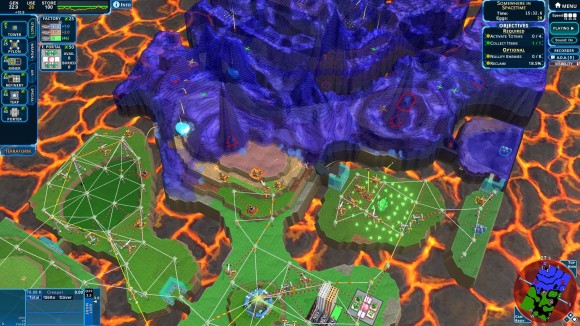
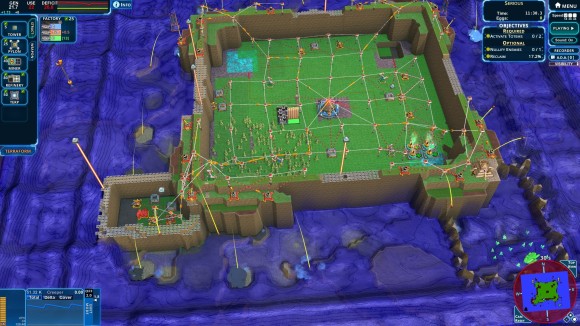
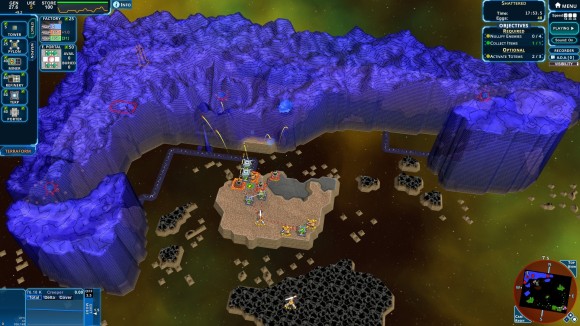
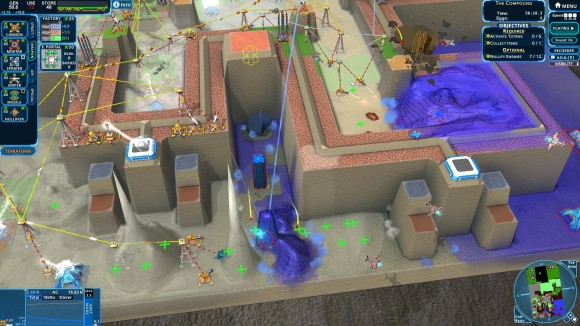
Weird world’s / strange adventures in infinite space sadly did not make the jump to 3d nearly as well which I always felt was a pitty, but I suppose its final 2d incarnation was practically as perfect as it can be ????????♂️